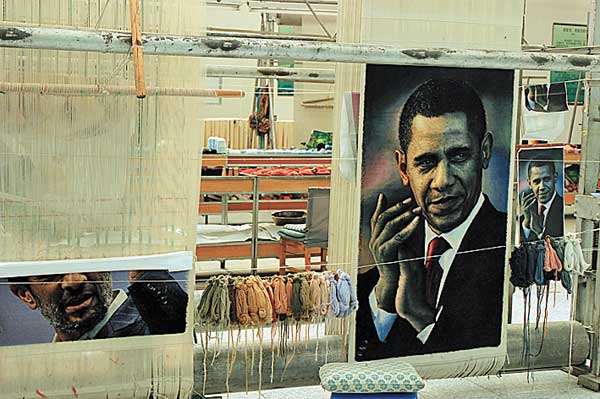 |
| A portrait of US President Barack Obama can be found in the workshop of Liwang Crafts and Arts Company. Wang Kaihao/China Daily |
What's the top must-see sight for visitors spending only one afternoon in the downtown area of Chifeng, the most populous city in the east of the Inner Mongolia autonomous region? Several locals offer a surprisingly identical answer: a factory.
Perhaps it is more suitable to call Liwang Crafts and Arts Company an arts gallery, especially on this quiet Saturday afternoon. Numerous tapestries of various sizes hang all around the spacious workshop. The salvo of abundant colors makes it hard for viewers to focus on a single work. The images include landscapes, portraits, and mimicked famous paintings from all over the world - all so lifelike you wouldn't know they are woolen without touching them.
The loom and manufacturing process look no different than those for other traditional tapestries or carpet-making in China - except for the overwhelming scrutiny to detail.
Most blueprints are drawn on simple A4 paper, and 200-odd workers in the factory have to duplicate them into much larger woolen versions. A strand of wool used for weaving contains five to eight fibrous threads in gradually changing colors.
Rainbow bright
"Color is the most crucial part of these tapestries," explains Sun Lijie, the chief engineer of the factory. "It is common to use more than 600 colors weaving a portrait. Sometimes it takes more than 200 to make one face vivid."
A piece portraying Mu Guiying, a legendary woman general in ancient China and a famous figure in Peking Opera, involves more than 1,000 colors, easily one of the most colorful works.
Veteran weaver Li Hongwei is one of seven engineers who select strands of the right colors for weaving the tapestries. It usually takes one week to analyze an original painting and divide it into hundreds of different colors.
"Some colors may look the same in your eyes, but each one is different," says the woman with 26 years' weaving experience. "Still, we sometimes find the strings are not quite the right color when weaving the tapestries, even though we've made careful preparations."
The scrupulous weaving process is very time-consuming. For example, about 0.77 square meter (about 30/40 inches) of tapestry can take one regular worker four-and-a-half months to complete.
However, Li says that is trivial compared with a mimic of Beihai Park's Nine-Dragon Wall. It took Li and 26 other workers' 366 days to finish this giant tapestry, 27 meters long and 6.65 meters high.
"Sometimes it is even more difficult when several people cooperate on one piece, because all participants have to weave at the same pace and same standard," she says. "People will thus not see any gap between different parts."
